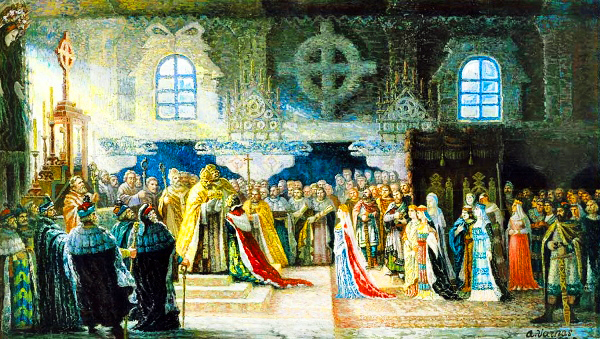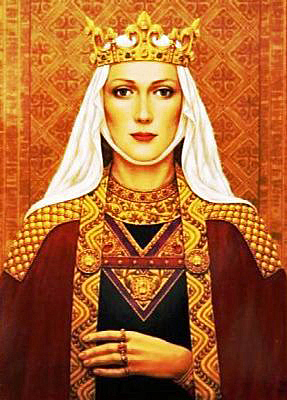| lithaz.org: home & art/culture events organizations publications |
| 5/15/2015 |
Lithuanian history:Mindaugas |
|||
| |||
UnifierOf the three main branches of the Baltic people, only Lithuanians formed their own state, The other two, Prussians and Latvians, were conquered by Germans with the backing of the Roman Catholic Church and the Holy Roman Emperor. Lithuanians managed to preserve their independence largely due to the efforts of Duke Mindaugas, a man of great energy and ability. Mindaugas united all Lithuanians under his rule, forming a large and powerful state.
Mindaugas was born in the late 1100s to a family of a powerful regional ruler possibly residing in Kernavė. Of his family very little is known, except that he had an older brother named Dausprungas. Both Mindaugas and his brother along with 19 other Lithuanian dukes are signers of a peace treaty with the rulers of Volhynia in the year 1219. This shows that regional rulers in Lithuania were already coordinating their actions for their common security and that some of the Lithuanian dukes were identified as being more senior and influential. While this treaty helped to secure Lithuanian lands from attacks in the southeast, a more serious situation was developing in the north and the southwest. To the north in Livonia (today's Latvia and Estonia) a German military order of monks, commonly called The Order of the Sword or Swordbrothers, because of the red sword insignia on their white tunics, was established by Archbishop Albert of Riga in 1202 and was systematically subjugating the native populations of Livs, Cours, Semgallians, Latgallians, Selonians, and Estonians. To the southwest another order of German warrior-monks known as the Teutonic Knights, established themselves on the banks of the Vistula River in 1230 and were conquering the native populations of Bartians, Galindians, Nadrovians, Nattangians, Sambians, Scalovians, Pogesanians, Pomesanians, and Varmians in Prussia ( today's Kaliningrad). Battle of SaulėHaving achieved their goals in Livonia, the Swordbrothers started conducting systematic attacks on Lithuania in 1229. Christians of that period believed that there was no room in Europe for pagan people and that Christians had every right to kill pagans and to take their lands - a popular idea in densely populated Germany. In that spirit Pope Gregory IX called for a crusade against the still pagan Lithuanians on February 19, 1236. Soon a large army of crusaders gathered in Riga from many parts of Germany, eager to fight the heathen Lithuanians. On his part Master Volquin of the Swordbrothers raised an additional force of about 3,000 including Rusian (East Slav) contingents from Pskov and Novgorod, two cities that had suffered from Lithuanian raids, and they all marched south into the Lithuanian region of Samogitia, where they split up into many bands and proceeded to kill the unsuspecting people living south of the Saulė River and to burn and loot their settlements. While they were devastating the countryside at will and unopposed, word of the attack spread fast. When finally the crusaders' lust for killing, looting and burning was spent, the marauding bands joined up for the march back to Riga. On September 22nd near the Saulė River in the vicinity of the today's city of Šiauliai, however, the crusaders found their way blocked by a waiting Samogitian armed force commanded by Mindaugas' brother-in-law Duke Vykintas of Samogitia,
By now the crusaders were tired and no longer eager for battle. When the Samogitians attacked, the crusaders scattered and were "cut down like women". Master Volquin and over ninety percent of the crusader force perished. A few managed to escape through the thick forests in the area, but even these survivors had to run the gauntlet of the natives as they crossed Semgallia to get back to Riga. It was a total disaster.
End of Swordbrothers
The Swordbrother Order was devastated. Only those who stayed behind on garrison duty were left - fify or sixty knights and about 600 garrison troops. Native Semgallians took advantage of the situation and rose up in rebellion against their German overlords. Swordbrothers appealed for help to the grandmaster of the Teutonic Knights in Prussia, and on May 12, 1237, Pope Gregory IX formally incorporated the Swordbrothers into the Teutonic Order - they became the Livonian branch of the Teutonic Knights. Although belonging to the same organization, the two branches were physically separated by Samogitian lands. This made it very difficult to coordinate the Order's military operations. It was also very difficult to bring German colonists into Livonia. Thus the need for a German land bridge between he two branches of the Order was an important reason for a century and a half of almost continual warfare between the Teutonic Knights and Lithuania. ( The Knights' power was eventually crushed in 1410 at the battle of Tannenberg. ) Expanding RuleAfter the victory at Saulė and he death of his brother Dausprungas (ca. 1238), Mindaugas started to expand his rule in Lithuania and to extend it into neighboring lands: Yotvingian land south of the upper Nemunas River and Rusian lands on Lithuania's eastern border. By 1240 Mindaugas was already the most powerful duke in Lithuania, but he was not finished yet. In an attempt to annex the lands of the Cours, a Baltic tribe living along the Baltic Sea between the Nemunas and Daugava rivers, Mindaugas invaded Couronia in the winter of 1244/45 and assaulted the Teutonic Knights' fortress at Embute. The assault failed to capture the fortress and frustrated Mindaugas' plans for Couronia.
In 1246 Mindaugas moved against the allies of the Teutonic Knights and enemies of his sister's son Lengvenis in the northeastern Lithuanian region of Nalšia.
Anti-Mindaugas AllianceIn 1248-49 Mindaugas moved to end the opposition to his rule in north Samogitia by his relatives - Tautvila and Gedvydas, the two sons of his brother Dausprungas, and Duke Vykintas of Samogitia, his brother-in-law. The trio, however, had a strong ally in Duke Danilo of Volhynia, who was married to Tautvila's and Gedvydas' sister and who was alarmed by Mindaugas' growing power. Their alliance against Mindaugas was soon joined by the Teutonic Knights. Duke Danilo started attacks against Mindaugas in the south capturing Slonim and Volkovysk, while Tautvila, Gedvydas, Vykintas, and the Teutonic Knights attacked, but failed to capture Mindaugas in his Voruta stronghold in 1249. In 1250 the Teutonic Knights devastated large areas of Lithuania. Tautvila was baptised in Riga and was nominated as the future monarch of Lithuania.
Mindaugas needed to break up the strong alliance against him. He sent gifts to the Grandmaster Andrew von Stirland of the Teutonic Knights and sued for peace. Andrew required Mindaugas to convert to Christianity as the Order's condition for switching its support to him. Mindaugas, not seeing a better way out, agreed to convert.
BaptismIn the winter of 1250/51, Mindaugas, his wife Morta, and most nobles of his court were baptised as Roman Catholics at Voruta. A delegation with the news of Mindaugas' baptism was sent to Pope Innocent IV. They found the pope in Milan in July of 1251. On July 15 the pope sent a letter to the bishop of Culm about the conversion of Lithuanians and instructed him to take charge of the organization of the Lithuanian Roman Catholic Church and to be gentle in the collection of the Church's tithe. On July 17 the pope issued three bulls in Mindaugas' favor: (1) Mindaugas was declared to be the son of the Holy Roman Catholic Church; Mindaugas, his family, and his followers were now under the Church's protection; and all the lands Mindaugas now rules and the lands he will conquer from unbelievers are recognized as his property; (2) Livonian bishops of Oesel and Couronia were made the guarantors of the above privileges; (3)the bishop of Culm in Prussia was instructed to crown Mindaugas as king on the condition that he and his heirs recognize the Lithuanian State to be the property of Saint Peter's Throne.
Having gained the protection of the Church, in 1251 Mindaugas led an armed force against his opponents in Samogitia. In a battle near Tverai, Duke Vykintas of Samogitia perished, Tautvila and Gedvydas fled to Volhynia, victorious Mindaugas was wounded and had to return to Voruta. After the battle at Tverai, Treniota became the new leader of the Samogitians. It is believed that Treniota was Vykintas' son.
Building of Klaipėda (Memel)
To help bridge the gap between the lands of the two branches of the Teutonic Knights, the Knights built a fortress in 1252 just north of where the Nemunas River flows into a bay of the Baltic Sea. The bay is called the Couronian Sea and the fortress was called Memel (Lith.: Klaipėda). Memel had a safe harbor, easy access to both the Nemunas River and the Baltic Sea, and was about halfway between Prussia and Livonia. Memel fortress became an important staging point for Teutonic Knight attacks into Samogitia as well as a choke point for important trade between Samogitians and Sambians.
Coronation
Mindaugas was crowned on July 6, 1253 as King of Lithuania with a crown supplied by the Pope and brought by the grandmaster of the Teutonic Knights. The ceremony was performed by the bishop of Culm.
Donation of Territory in Samogitia
To support the new Roman Catholic bishopric which was established in Lithuania, Mindaugas donated the Samogitian towns of Raseiniai, Ariogala, and Laukuva. Additional Samogitian land was given the Teutonic Order as a reward for their help. These were areas that resisted Mindaugas' rule. It is fair to say that Mindaugas did not win any friends in Samogitia by his actions of becoming a Christian and donating their lands to the Knights. Samogitians continued their war with the Teutonic Knights: major battles were fought at Skuodas in 1259 and at Durbė in 1261.
Peace with Volhynia
Having made peace with the Teutonic Knights, Mindaugas decided to reclaim the territory lost to Duke Danilo of Volhynia. A Lithuanian armed force led by Mindaugas' oldest son Vaišvilkas (a.k.a. Vaišelga) invaded Danilo's lands, defeated him, and forced him to seek peace in 1255. The peace treaty was strengthened by the marriage of Mindaugas' daughter and Danilo's son Shvarno.Mindaugas made Danilo's other son Roman the ruler of Novgorodok (Lith.: Naugardukas) and his own son Vaišvilkas the ruler of Slonim, Volkovysk, and other recaptured cities. Both Roman and Vaišvilkas had to recognize Mindaugas' supremacy and to rule as his vassals. As part of the same treaty, Mindaugas pardoned his enemies Tautvila and Gedvydas. Later Mindaugas made Tautvila the duke of Polotsk.
Morta's Death
In 1262 Mindaugas' wife Morta died. As was the custom, Mindaugas invited her sister, the wife of Duke Daumantas of Nalšia, to come and mourn her sister's passing. After Morta's funeral, however, Mindaugas told her sister that she could not leave, because he had promised Morta to marry her, for Morta did not want her youngest children to be raised by anyone else. Daumantas was very offended and determined to seek revenge. Treniota, who had his own grievances against Mindaugas, joined Daumantas in the plot against Mindaugas.
Mindaugas' DeathAn opportunity for the plotters came in September of 1263, when Mindaugas sent off his forces to fight in Bryansk and was visiting his domain with only a small escort. Daumantas and Treniota surprised Mindaugas and killed him and the two sons rhat were with him. Mindaugas' oldest son Vaišvilkas was away at that time and survived.
Thus ended the life of Mindaugas, first ruler of the unified Lithuanian State, first and only King of Lithuania. In spite of all his achievements and fame, his gravesite has not been found. (Click here to read more history.) 
"Coronation of Mindaugas" 1953 painting by Adomas Varnas |

